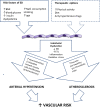Endothelial dysfunction as a factor leading to arterial hypertension
- PMID: 36409370
- PMCID: PMC10432334
- DOI: 10.1007/s00467-022-05802-z
Endothelial dysfunction as a factor leading to arterial hypertension
Abstract
Hypertension remains the main cause of cardiovascular complications leading to increased mortality. The discoveries of recent years underline the important role of endothelial dysfunction (ED) in initiating the development of arterial hypertension. The endothelium lines the interior of the entire vascular system in the body and acts as a physical barrier between blood and tissues. Substances and mediators produced by the endothelium exhibit antithrombotic and anti-inflammatory properties. Oxidative stress and inflammation are conditions that damage the endothelium and shift endothelial function from vasoprotective to vasoconstrictive, prothrombotic, and pro-apoptotic functions. A dysfunctional endothelium contributes to the development of hypertension and further cardiovascular complications. Reduced nitric oxide (NO) bioavailability plays an essential role in the pathophysiology of ED-associated hypertension. New technologies provide tools to identify pathological changes in the structure and function of the endothelium. Endothelial dysfunction (ED) contributes to the development of arterial hypertension and should be considered in therapeutic strategies for children with hypertension.
Keywords: Cardiovascular risk; Children; Endothelial dysfunction; Hypertension.
© 2022. The Author(s).
Conflict of interest statement
The authors declare no competing interests.
Figures
Similar articles
-
Working under pressure: the vascular endothelium in arterial hypertension.J Hum Hypertens. 2000 Oct-Nov;14(10-11):617-30. doi: 10.1038/sj.jhh.1001012. J Hum Hypertens. 2000. PMID: 11095155 Review.
-
Curcumin improves endothelial dysfunction and vascular remodeling in 2K-1C hypertensive rats by raising nitric oxide availability and reducing oxidative stress.Nitric Oxide. 2014 Nov 15;42:44-53. doi: 10.1016/j.niox.2014.09.001. Epub 2014 Sep 4. Nitric Oxide. 2014. PMID: 25194767
-
Endothelial function and hypertension.Curr Opin Cardiol. 2007 Jul;22(4):316-20. doi: 10.1097/HCO.0b013e3281ca710d. Curr Opin Cardiol. 2007. PMID: 17556884 Review.
-
Nebivolol: impact on cardiac and endothelial function and clinical utility.Vasc Health Risk Manag. 2012;8:151-60. doi: 10.2147/VHRM.S20669. Epub 2012 Mar 13. Vasc Health Risk Manag. 2012. PMID: 22454559 Free PMC article. Review.
-
Vascular nitric oxide and oxidative stress: determinants of endothelial adaptations to cardiovascular disease and to physical activity.Can J Appl Physiol. 2005 Aug;30(4):442-74. doi: 10.1139/h05-133. Can J Appl Physiol. 2005. PMID: 16258183 Review.
Cited by
-
Amino acid profile in overweight and obese prepubertal children - can simple biochemical tests help in the early prevention of associated comorbidities?Front Endocrinol (Lausanne). 2023 Oct 26;14:1274011. doi: 10.3389/fendo.2023.1274011. eCollection 2023. Front Endocrinol (Lausanne). 2023. PMID: 37964971 Free PMC article.
-
Exploring novel markers for coronary heart disease associated with systemic lupus erythematosus: A review.Medicine (Baltimore). 2024 Dec 13;103(50):e40773. doi: 10.1097/MD.0000000000040773. Medicine (Baltimore). 2024. PMID: 39686502 Free PMC article. Review.
-
Aging aggravates cognitive dysfunction in spontaneously hypertensive rats by inducing cerebral microvascular endothelial dysfunction.PLoS One. 2025 Mar 13;20(3):e0316383. doi: 10.1371/journal.pone.0316383. eCollection 2025. PLoS One. 2025. PMID: 40080509 Free PMC article.
-
Efficacy and safety evaluation of Allisartan Isoproxil in patients with hypertension: a meta-analysis.Front Cardiovasc Med. 2024 Jun 6;11:1355014. doi: 10.3389/fcvm.2024.1355014. eCollection 2024. Front Cardiovasc Med. 2024. PMID: 38903964 Free PMC article.
-
Hydrogen Sulfide Modulation of Matrix Metalloproteinases and CD147/EMMPRIN: Mechanistic Pathways and Impact on Atherosclerosis Progression.Biomedicines. 2024 Aug 26;12(9):1951. doi: 10.3390/biomedicines12091951. Biomedicines. 2024. PMID: 39335465 Free PMC article. Review.
References
-
- Cines DB, Pollak ES, Buck CA, Loscalzo J, Zimmerman GA, McEver RP, Pober JS, Wick TM, Konkle BA, Schwartz BS, Barnathan ES, McCrae KR, Hug BA, Schmidt AM, Stern DM. Endothelial cells in physiology and in the pathophysiology of vascular disorders. Blood. 1998;91:3527–3561. - PubMed
MeSH terms
Substances
LinkOut - more resources
Full Text Sources
Medical


